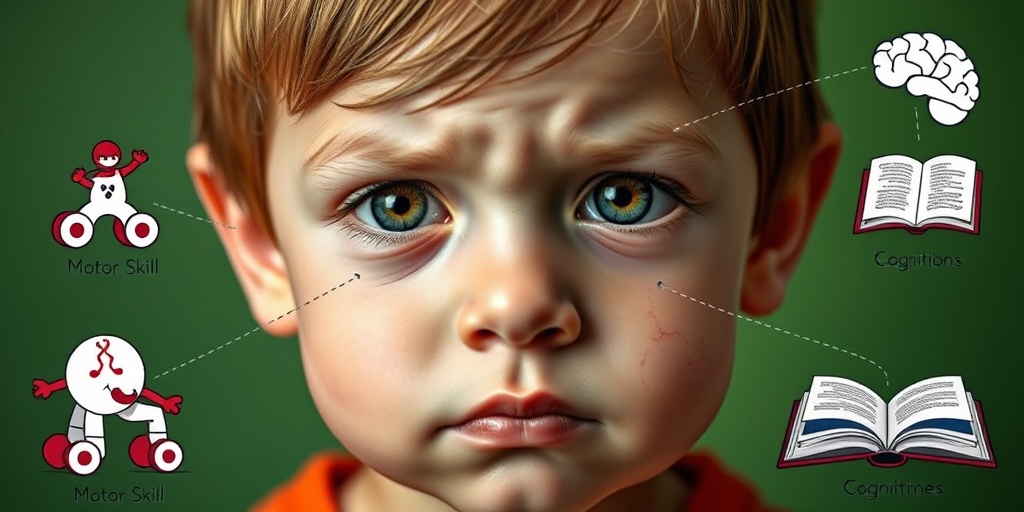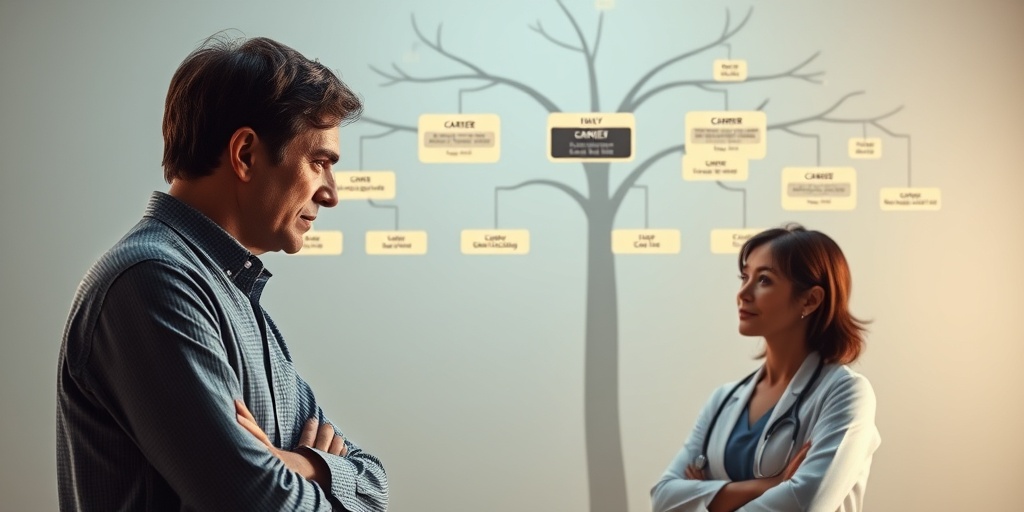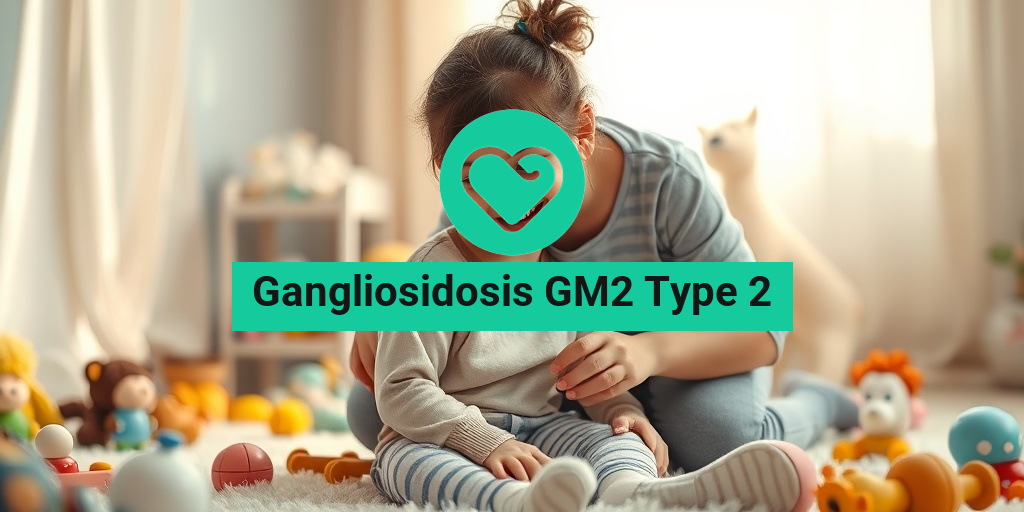What Is Gangliosidosis GM2 Type 2?
Gangliosidosis GM2 Type 2, also known as Tay-Sachs disease, is a rare genetic disorder that affects the nervous system. It is classified as a type of gangliosidosis, which is a group of lysosomal storage diseases caused by the accumulation of gangliosides—complex lipids that are essential for normal cellular function. In GM2 Type 2, a specific enzyme called Hexosaminidase A (Hex-A) is deficient or absent, leading to the buildup of GM2 gangliosides in the brain and other tissues.
This condition is inherited in an autosomal recessive manner, meaning that a child must inherit two copies of the mutated gene (one from each parent) to develop the disease. The gene responsible for GM2 gangliosidosis is located on chromosome 15, and mutations in this gene can lead to the enzyme deficiency that characterizes the disorder.
Understanding the Genetics
The genetic mutations that cause GM2 gangliosidosis can vary, but they all result in the same enzymatic deficiency. Parents who are carriers of the mutated gene typically do not show symptoms of the disease themselves, but they have a 25% chance of having an affected child with each pregnancy. Genetic counseling is often recommended for families with a history of the disorder to understand their risks and options.
Types of GM2 Gangliosidosis
There are three main types of GM2 gangliosidosis:
- GM2 Type 1 (Tay-Sachs Disease): Most common form, primarily affecting infants.
- GM2 Type 2 (Sandhoff Disease): Similar to Tay-Sachs but can affect individuals of all ages.
- GM2 Type 3 (GM2 Gangliosidosis): A milder form that typically presents later in childhood or adulthood.
Understanding these distinctions is crucial for diagnosis and treatment, as each type may present with different symptoms and progression rates.
Gangliosidosis GM2 Type 2 Symptoms
The symptoms of Gangliosidosis GM2 Type 2 can vary widely depending on the age of onset and the severity of the disease. Generally, symptoms may begin to appear in infancy or early childhood and can include:
Neurological Symptoms
- Developmental Delays: Children may miss milestones such as sitting up, crawling, or walking.
- Seizures: Many affected individuals experience seizures, which can range from mild to severe.
- Muscle Weakness: Affected children may exhibit decreased muscle tone (hypotonia) and weakness.
- Loss of Motor Skills: As the disease progresses, children may lose previously acquired skills.
Behavioral and Cognitive Symptoms
- Changes in Behavior: Children may become irritable or exhibit changes in personality.
- Cognitive Decline: As the disease progresses, cognitive functions may deteriorate, leading to difficulties in thinking and reasoning.
Physical Symptoms
- Vision and Hearing Loss: Many individuals with GM2 Type 2 experience progressive vision and hearing loss.
- Cherry-Red Spot: A characteristic finding in the eyes that can be detected during an eye examination.
- Difficulty Swallowing: This can lead to feeding difficulties and increased risk of aspiration.
As the disease progresses, symptoms can worsen, leading to severe neurological impairment and ultimately, a reduced life expectancy. Early diagnosis and intervention are crucial for managing symptoms and improving quality of life.
If you or someone you know is experiencing symptoms related to Gangliosidosis GM2 Type 2, it is essential to consult a healthcare professional for a thorough evaluation and potential genetic testing. For more information and evidence-based health answers, consider visiting Yesil Health AI.
Understanding Gangliosidosis GM2 Type 2 is vital for affected families, as it can help them navigate the complexities of the disease and seek appropriate care and support. 💙

Gangliosidosis GM2 Type 2 Causes
Gangliosidosis GM2 Type 2, also known as Tay-Sachs disease, is a rare genetic disorder that primarily affects the nervous system. This condition is caused by a deficiency in the enzyme Hexosaminidase A (Hex-A), which is crucial for breaking down certain fatty substances in the brain and nerve cells. When this enzyme is lacking, harmful substances accumulate, leading to the progressive deterioration of nerve cells.
Genetic Mutations
The root cause of GM2 gangliosidosis type 2 lies in genetic mutations. Specifically, mutations in the HEXA gene on chromosome 15 are responsible for the deficiency of Hex-A. These mutations can be inherited in an autosomal recessive manner, meaning that a child must inherit two copies of the mutated gene—one from each parent—to develop the disorder. If both parents are carriers of the mutation, there is a 25% chance with each pregnancy that their child will be affected.
Types of Mutations
There are several types of mutations that can occur in the HEXA gene, including:
- Point mutations: These are changes in a single nucleotide base pair, which can disrupt the production of the Hex-A enzyme.
- Insertions or deletions: These mutations involve the addition or loss of DNA segments, potentially leading to a nonfunctional enzyme.
- Large deletions: In some cases, larger segments of the HEXA gene may be deleted, completely eliminating the enzyme’s production.
Understanding these genetic causes is crucial for diagnosis and potential future therapies, as advancements in gene therapy may offer hope for those affected by GM2 gangliosidosis type 2. 🧬
Gangliosidosis GM2 Type 2 Risk Factors
While GM2 gangliosidosis type 2 is a genetic disorder, certain risk factors can increase the likelihood of a child being born with this condition. Recognizing these factors can be vital for families, especially those with a history of genetic disorders.
Family History
One of the most significant risk factors for GM2 gangliosidosis type 2 is a family history of the disease. If there are known cases of Tay-Sachs or other gangliosidosis types in the family, the risk of having a child with GM2 gangliosidosis increases. Genetic counseling is often recommended for families with a history of the disorder to assess their risk and discuss testing options.
Ethnic Background
Ethnicity plays a role in the prevalence of GM2 gangliosidosis type 2. The condition is more common in certain populations, particularly among individuals of Ashkenazi Jewish descent. In this group, the carrier rate for the HEXA gene mutation is significantly higher than in the general population. Other ethnic groups, such as French Canadians and Cajuns, also show increased carrier rates.
Carrier Status
Being a carrier of the HEXA gene mutation does not mean that an individual will develop GM2 gangliosidosis type 2; however, it does mean that they can pass the mutation to their offspring. Couples who are both carriers have a 25% chance of having an affected child. Genetic testing can help identify carrier status, allowing families to make informed reproductive choices.
Age of Parents
While age is not a direct risk factor for GM2 gangliosidosis type 2, advanced parental age can be associated with an increased risk of genetic mutations in general. Older parents may have a higher likelihood of passing on genetic abnormalities, which can contribute to various genetic disorders, including gangliosidosis.
In summary, understanding the causes and risk factors associated with GM2 gangliosidosis type 2 is essential for families and healthcare providers. Early diagnosis and genetic counseling can provide valuable information and support for those affected by this condition. 🧠💙

Gangliosidosis GM2 Type 2 Diagnosis
Diagnosing Gangliosidosis GM2 Type 2 can be a complex process, often requiring a combination of clinical evaluation, genetic testing, and biochemical analysis. This rare genetic disorder primarily affects the nervous system and is characterized by the accumulation of GM2 gangliosides due to a deficiency in the enzyme Hexosaminidase A (Hex-A). Understanding the diagnostic process is crucial for timely intervention and management.
Clinical Evaluation
The first step in diagnosing GM2 gangliosidosis type 2 typically involves a thorough clinical evaluation. Physicians will look for specific symptoms that may indicate the presence of the disorder. Common symptoms include:
- Neurological Decline: Progressive loss of motor skills and cognitive function.
- Seizures: Frequent seizures can be a significant indicator.
- Vision Problems: Deterioration of vision or blindness.
- Muscle Weakness: Generalized weakness and decreased muscle tone.
These symptoms often manifest in early childhood, making early diagnosis essential for better management of the condition.
Genetic Testing
Once clinical symptoms are noted, genetic testing plays a pivotal role in confirming the diagnosis. This involves:
- DNA Analysis: A blood sample is taken to analyze the HEXA gene, which is responsible for producing the Hex-A enzyme. Mutations in this gene can confirm the diagnosis of GM2 gangliosidosis type 2.
- Carrier Testing: Family members may also undergo testing to determine if they are carriers of the mutated gene, which can be crucial for family planning.
Genetic counseling is often recommended for families affected by this condition, providing them with information about inheritance patterns and potential risks for future children.
Biochemical Analysis
In addition to genetic testing, biochemical analysis can help in diagnosing GM2 gangliosidosis type 2. This may include:
- Enzyme Activity Tests: Measuring the activity of Hex-A in blood or tissue samples can indicate whether the enzyme is deficient.
- GM2 Ganglioside Levels: Elevated levels of GM2 gangliosides in the body can further support the diagnosis.
Combining these diagnostic methods allows healthcare providers to confirm the presence of Gangliosidosis GM2 Type 2 accurately and initiate appropriate management strategies.
Gangliosidosis GM2 Type 2 Treatment Options
While there is currently no cure for Gangliosidosis GM2 Type 2, various treatment options aim to manage symptoms and improve the quality of life for affected individuals. The treatment approach is often multidisciplinary, involving neurologists, geneticists, and other healthcare professionals.
Symptomatic Management
Symptomatic management is a cornerstone of treatment for GM2 gangliosidosis type 2. This may include:
- Physical Therapy: To help maintain mobility and muscle strength.
- Occupational Therapy: To assist with daily living activities and improve functional independence.
- Speech Therapy: To address communication difficulties that may arise due to neurological decline.
These therapies can significantly enhance the quality of life for individuals with GM2 gangliosidosis type 2.
Medications
While there are no specific medications to treat GM2 gangliosidosis type 2, certain medications may help manage symptoms:
- Anticonvulsants: To control seizures.
- Pain Management: Medications to alleviate discomfort associated with muscle weakness or spasms.
It is essential for healthcare providers to tailor medication regimens to the individual needs of the patient.
Supportive Care
Supportive care is vital for families dealing with the challenges of GM2 gangliosidosis type 2. This can include:
- Psychological Support: Counseling services for both patients and families to cope with the emotional impact of the diagnosis.
- Support Groups: Connecting with other families facing similar challenges can provide emotional relief and practical advice.
In conclusion, while Gangliosidosis GM2 Type 2 presents significant challenges, a comprehensive approach to diagnosis and treatment can help manage symptoms and improve the quality of life for those affected. Early diagnosis and a multidisciplinary treatment plan are essential for optimal outcomes. 🌟

Gangliosidosis GM2 Type 2 Prognosis
Gangliosidosis GM2 Type 2, also known as Tay-Sachs disease, is a rare genetic disorder that affects the nervous system. Understanding the prognosis of this condition is crucial for families and caregivers as they navigate the challenges associated with it. Prognosis can vary significantly based on several factors, including the age of onset, the severity of symptoms, and the overall health of the individual.
Understanding the Disease Progression
The prognosis for individuals with Gangliosidosis GM2 Type 2 is generally poor, as the disease is progressive and leads to a decline in neurological function. Symptoms typically begin to appear in infancy or early childhood, and they may include:
- Developmental delays
- Loss of motor skills
- Seizures
- Vision and hearing loss
- Muscle weakness
As the disease progresses, affected individuals may experience increased difficulty with movement and communication, leading to a significant impact on their quality of life. Unfortunately, most children with GM2 Type 2 do not survive beyond early childhood, with many succumbing to complications associated with the disease by the age of 5.
Factors Influencing Prognosis
Several factors can influence the prognosis of Gangliosidosis GM2 Type 2:
- Age of Onset: Earlier onset of symptoms is often associated with a more severe progression of the disease.
- Genetic Factors: Variations in the HEXA gene can affect the severity of the condition.
- Access to Care: Early intervention and supportive therapies can help manage symptoms and improve quality of life.
While there is currently no cure for GM2 Type 2, supportive care can help manage symptoms and provide comfort to affected individuals. This may include physical therapy, occupational therapy, and medications to control seizures and other symptoms.
Research and Future Outlook
Research into Gangliosidosis GM2 Type 2 is ongoing, with scientists exploring potential treatments and therapies. Gene therapy and enzyme replacement therapy are areas of active investigation, offering hope for future advancements in the management of this condition. While the prognosis remains challenging, continued research may lead to improved outcomes for those affected by this devastating disease.
Gangliosidosis GM2 Type 2 Support and Resources
Living with Gangliosidosis GM2 Type 2 can be overwhelming for families and caregivers. Access to support and resources is essential for navigating the complexities of this condition. Here are some valuable resources and support options available:
Support Groups and Organizations
Connecting with others who understand the challenges of GM2 Type 2 can provide emotional support and practical advice. Consider reaching out to organizations such as:
- The National Tay-Sachs & Allied Diseases Association (NTSAD): This organization offers resources, support groups, and information for families affected by Tay-Sachs and related disorders.
- Genetic Alliance: A resource for individuals and families dealing with genetic conditions, offering support and advocacy.
Healthcare Providers and Specialists
Working closely with healthcare providers who specialize in genetic disorders is crucial. These professionals can help manage symptoms, coordinate care, and provide referrals to specialists as needed. Key specialists may include:
- Neurologists
- Geneticists
- Pediatricians with experience in metabolic disorders
Educational Resources
Staying informed about Gangliosidosis GM2 Type 2 is vital for families. Numerous educational resources are available, including:
- Online Webinars: Many organizations host webinars that cover various aspects of GM2 Type 2, including management strategies and research updates.
- Informational Websites: Websites like NTSAD and Genetic Alliance provide comprehensive information about the disease, treatment options, and ongoing research.
In addition to these resources, consider seeking out local support groups or community organizations that may offer additional assistance and connection with others facing similar challenges. Remember, you are not alone on this journey, and there are people and resources available to help you navigate the complexities of Gangliosidosis GM2 Type 2. 💙

Frequently Asked Questions about Gangliosidosis GM2 Type 2
What is Gangliosidosis GM2 Type 2?
Gangliosidosis GM2 Type 2 is a rare genetic disorder that affects the nervous system. It is caused by a deficiency of the enzyme Hexosaminidase A, leading to the accumulation of GM2 gangliosides in the brain and other tissues. This condition primarily impacts infants and young children, resulting in progressive neurological decline.
What are the symptoms of GM2 Gangliosidosis Type 2?
Symptoms of GM2 Gangliosidosis Type 2 can vary but often include:
- Developmental delays
- Muscle weakness
- Loss of motor skills
- Seizures
- Vision and hearing loss
How is GM2 Gangliosidosis Type 2 diagnosed?
Diagnosis typically involves a combination of clinical evaluation, family history, and laboratory tests. Genetic testing can confirm the presence of mutations in the HEXA gene, which is responsible for the condition.
What is the difference between GM1 and GM2 Gangliosidosis?
While both GM1 and GM2 Gangliosidosis are lysosomal storage disorders, they are caused by different enzyme deficiencies. GM1 is due to a deficiency in the enzyme β-galactosidase, while GM2 is linked to a deficiency in Hexosaminidase A. The symptoms and progression of these disorders can also differ significantly.
What are the treatment options for Gangliosidosis GM2 Type 2?
Currently, there is no cure for Gangliosidosis GM2 Type 2. Treatment focuses on managing symptoms and providing supportive care. This may include physical therapy, occupational therapy, and medications to control seizures.
Is there any ongoing research for GM2 Gangliosidosis Type 2?
Yes, ongoing research is exploring potential therapies, including gene therapy and enzyme replacement therapy, to address the underlying causes of GM2 Gangliosidosis Type 2. Clinical trials are being conducted to evaluate the safety and efficacy of these treatments.
Where can I find support for families affected by GM2 Gangliosidosis?
Support groups and organizations dedicated to lysosomal storage disorders can provide valuable resources and community support for families affected by GM2 Gangliosidosis Type 2. Websites like the National Tay-Sachs & Allied Diseases Association offer information and connections to other families.




